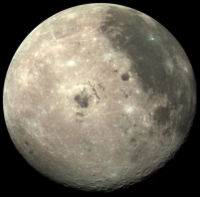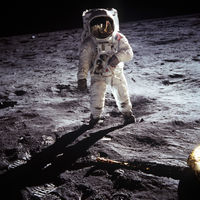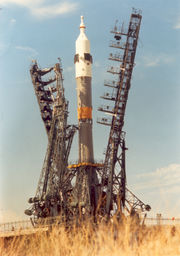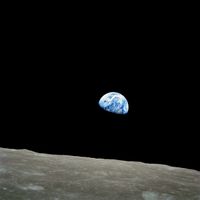Moon landing
2007 Schools Wikipedia Selection. Related subjects: Space transport
The first moon landing by a human was that of American Neil Armstrong, commander of the Apollo 11 mission, accompanied by Buzz Aldrin. On July 20, 1969, while their teammate Michael Collins controlled the command module Columbia, Armstrong landed the lunar module Eagle on the surface of the moon at 4:17:42 p.m. Eastern Daylight Time. This article covers the events immediately surrounding the successful moon landing. For more information on the U.S.S.R./U.S. contest to be the first on the moon, see space race, and for more information regarding the mission, see Project Apollo.
Lunar missions

Unmanned missions
The Soviet Luna program had launched Luna 1, the first spacecraft to fly past the moon on January 4, 1959. Its successor, Luna 2, was the first spacecraft to land on the moon, while Luna 3 took the first photos of the far side of the moon on October 7, 1959. Luna 9, launched by the USSR on February 3, 1966, performed the first "soft landing" on the moon; and Luna 10 became the first spacecraft to orbit the moon on April 3, 1966.
The Americans focused their efforts on sending a probe to the moon with their Pioneer program. However, three designs of probe on three different rocket launchers all failed in a total of ten attempts.
The robotic Surveyor program was part of the American effort to locate a safe site on the moon for a human landing. Five of Surveyor's seven missions were successful, helping to find the best target for the Apollo astronauts. Apollo 8 carried out the first manned orbit of the moon on December 27, 1968, laying the groundwork for placing a man on the moon.
First human on the moon
American strategy
The U.S. moon exploration program originated during the Eisenhower administration. In a series of mid-1950s articles in Collier's magazine, Wernher von Braun had popularized the idea of a manned expedition to the moon to establish a lunar base. A manned moon landing posed several daunting technical challenges to the USA and the USSR. Besides guidance and weight management, atmospheric re-entry without ablative overheating was a major hurdle. After the Soviet Union's launch of Sputnik, von Braun promoted a plan for the U.S. Army to establish a military lunar outpost by 1965. This idea did not proceed because the United States government believed that the potential for scientific or military reward failed to justify the expense of such an operation.
After the early Soviet successes, especially Yuri Gagarin's flight, U.S. president John F. Kennedy looked for an American project that would capture the public imagination. He asked vice president Lyndon Johnson to make recommendations on a scientific endeavor that would prove U.S. world leadership. The proposals included non-space options such as massive irrigation projects to end famine in the Third World. Of all the potential space missions to be attempted, it was determined that the U.S. would have the best chance of beating the Soviets in a race to a moon landing. This is because the Soviets, at the time, had more powerful rockets than the United States. Advances in U.S. nuclear weapons technology had led to smaller, lighter warheads, and consequently, rockets with smaller payload capacities. By comparison, Soviet nuclear weapons were much heavier, and the powerful R-7 rocket was developed to carry them. More modest potential missions such as flying around the moon without landing or establishing a space lab in orbit (both were proposed by Kennedy to von Braun) were determined to offer too much advantage to the Soviets, since the U.S. would have to develop a heavy rocket to match the Soviets. A moon landing, however, would offer the best chance of success to the U.S., since both countries would have to develop technology from scratch.
Mindful that the Apollo Program would economically benefit most of the key states in the next election, particularly his home state of Texas due to NASA's base in Houston, Johnson championed the Apollo program. This supported claims, made by Kennedy during the 1960 election, that the previous administration had allowed a " missile gap" between the U.S. and USSR (though intelligence reports had shown the reverse to be true) which had contributed to Kennedy's victory over Richard Nixon. The Apollo project allowed continued development of dual-use technology. Johnson also advised that for anything less than a lunar landing the USSR had a good chance of beating the U.S. For these reasons, Kennedy seized on Apollo as the ideal focus for American efforts in space. He ensured continuing funding, shielding space spending from the 1963 tax cut and diverting money from other NASA projects. This dismayed NASA's leader, James E. Webb, who urged support for other scientific work.
In conversation with Webb, Kennedy said:

- Everything we do ought to really be tied in to getting on to the moon ahead of the Russians [...] otherwise we shouldn't be spending that kind of money, because I'm not interested in space [...] The only justification for [the cost] is because we hope to beat [the USSR] to demonstrate that instead of being behind by a couple of years, by God, we passed them.2.
Whatever he said in private, Kennedy needed a different message to gain public support. Later in 1963, Kennedy asked Vice President Johnson to investigate the possible technological and scientific benefits of a moon mission. Johnson concluded that the benefits were limited but, with the help of scientists at NASA, put together a powerful case, citing possible medical breakthroughs and interesting pictures of earth from space. For the program to succeed, it would have to defeat criticism from politicians on the left, who wanted more money spent on social programs, and on those on the right, who favored a more military project. By emphasising the scientific payoff and playing on fears of Soviet space dominance, Kennedy and Johnson managed to swing public opinion: by 1965, 58 percent of Americans favored Apollo, up from 33 percent two years earlier. After Johnson became President in 1963, his continuing defense of the program allowed it to succeed in 1969, as Kennedy had originally hoped.
Russian strategy
Meanwhile, the USSR showed more ambivalence about going to the moon. Soviet leader Nikita Khrushchev did not relish "defeat" by any other power, but equally did not relish funding such an expensive project. In October 1963 he said that the USSR was "not at present planning flight by cosmonauts to the moon", qualifying this statement with his insistence that they had not dropped out of the race. Only after another year would the USSR fully commit itself to a moon-landing attempt.
At the same time, Kennedy had suggested various joint programs, including a possible moon landing by Soviet and American astronauts and the development of better weather-monitoring satellites. Khrushchev, sensing an attempt by Kennedy to steal Russian space technology, rejected the idea: if the USSR went to the moon, it would go alone. Korolev, the RSA's chief designer, had started promoting his Soyuz craft and the N-1 launcher rocket that would have the capability of carrying out a manned moon landing. Khrushchev directed Korolev's design bureau to arrange further space firsts by modifying the existing Vostok technology, while a second team started building a completely new launcher and craft, the Proton booster and the Zond, for a manned cislunar flight in 1966. In 1964 the new Soviet leadership gave Korolev the backing for a moon landing effort and brought all manned projects under his direction. With Korolev's death and the failure of the first Soyuz flight in 1967, the co-ordination of the Soviet moon landing program quickly unravelled. The Soviets built a landing craft and selected cosmonauts for the mission that would have placed Aleksei Leonov on the moon's surface, but with the successive launch failures of the N1 booster in 1969, plans for a manned landing suffered first delay and then cancellation.
Apollo 11 gets there first
While unmanned Soviet probes did reach the moon before any U.S. craft, American Neil Armstrong became the first person to walk on the lunar surface, after landing on July 20, 1969. Commander of the Apollo 11 mission, Armstrong received backup from command module pilot Michael Collins and lunar module pilot Buzz Aldrin in an event watched by over 500 million people around the world. Social commentators widely recognize the lunar landing as one of the defining moments of the 20th century, and Armstrong's words on his first stepping onto the moon's surface became similarly memorable:
That's one small step for [a] man, one giant leap for mankind.
Actual transcript of entire landing is here.
The astronauts set out an American flag, and Buzz Aldrin was photographed saluting it. While many people believe that some importance in the planning of the mission was that Armstrong, a civilian, was to be the first to set foot on the moon, this is not true. One of the original flight plans had the lunar module pilot (Buzz Aldrin) coming out first. Also of significance was the inscribed plaque unveiled by the astronauts and left affixed to the lunar lander which remained on the moon. The sentiment expressed set forth America's attitude about the landing and subsequent landings. Signed by Richard Nixon, President of the United States the plaque reads: "Here men from the planet earth first set foot upon the Moon July 1969 AD. We came in peace for all mankind" (the plaque is also signed by Neil Armstrong, Michael Collins, and Buzz Aldrin).
Other aspects of the moon landing
Unlike other international rivalries, the Space Race has remained unaffected in a direct way by the desire for territorial expansion. After its successful landings on the Moon, the U.S. explicitly disclaimed the right to ownership of any part of the Moon.
Some conspiracy theorists still insist that the lunar landing was a hoax. These Apollo moon landing hoax accusations flourish in part because, while many enthusiasts predicted that moon landings would become commonplace, except for the several ensuing Apollo landings in the next decade, such predictions have not yet come to pass. Many scientists, technicians and space enthusiasts who have commented on the accusations have rejected them as baseless. Public opinion polls in the United States have shown that a large majority accept the Apollo missions as fact, while a notable percentage have at least some doubts about them.
In the 1940s writer Arthur C Clarke forecast that man would reach the moon by the year 2000, an idea experts dismissed as rubbish. When Neil Armstrong landed in 1969, the United States said Clarke "provided the essential intellectual drive that led us to the moon."
On August 16, 2006 the Associated Press reported that NASA is currently missing the original Slow-scan television tapes (which were made before the scan conversion for conventional TV) of the Apollo 11 moonwalk. Some news outlets have mistakenly reported that the SSTV tapes were found in Western Australia, but those tapes were only recordings of data from the Apollo 11 Early Apollo Surface Experiments Package.
List of manned moon landings
- Apollo 11 - July 16, 1969. First manned landing on the Moon, July 20.
- Apollo 12 - November 14, 1969. First precise manned landing on the Moon.
- Apollo 14 - January 31, 1971. Alan Shepard, the sole astronaut of the Mercury MR-3 mission, walks on the Moon.
- Apollo 15 - July 26, 1971. First mission with the Lunar Rover vehicle.
- Apollo 16 - April 16, 1972. First landing in the lunar highlands.
- Apollo 17 - December 7, 1972. Final Apollo lunar mission, first night launch, only mission with a professional geologist.

